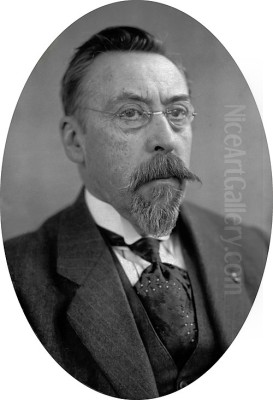
Bernard de Hoog stands as a significant figure in Dutch art history, particularly associated with the later phase of the Hague School. Born in Amsterdam in 1867 and passing away in The Hague in 1943, his life spanned a period of considerable artistic change in the Netherlands and Europe. De Hoog carved a distinct niche for himself, becoming renowned for his intimate and warmly rendered depictions of Dutch rural life, particularly focusing on the quiet dignity and simple joys found within peasant homes. His work, while rooted in the realist traditions of the Hague School, possesses a unique charm and accessibility that earned him widespread international acclaim during his lifetime.
From Commerce to Canvas: An Unconventional Path
Unlike many artists who follow a direct path through formal academies from a young age, Bernard de Hoog's journey into the art world was less conventional. His early professional life began not in a studio, but in the world of commerce. He spent some years working in an office, a setting seemingly far removed from the artistic pursuits that would later define his career. However, even within this commercial environment, his innate artistic inclinations began to surface. It's noted that he would often sketch and draw, perhaps finding moments of creative escape amidst ledgers and paperwork.
A pivotal moment came through the intervention of a supportive merchant. This individual, recognizing De Hoog's latent talent, possibly through observing his sketches, encouraged him to pursue art more seriously. This encouragement was not merely verbal; the merchant provided tangible support, initially commissioning De Hoog to paint a portrait of his wife. This commission served as both a validation of his potential and a practical step towards an artistic career, helping him finance further study and practice. This transition highlights a determination to follow his passion, even after an initial, less direct start in the professional world.
Artistic Formation: Teachers and Old Masters
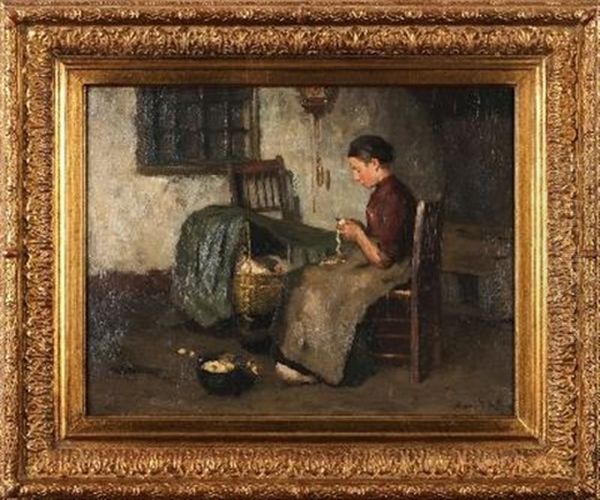
Having committed to an artistic path, De Hoog sought instruction to hone his skills. He studied under established figures such as Jan van Essen and J.F. van Quellinus. These teachers would have provided him with foundational techniques and guidance within the prevailing artistic norms of the time. However, much of De Hoog's development appears to have been driven by personal study and a deep reverence for the Dutch Golden Age masters who had excelled in depicting domestic life centuries earlier.
He dedicated significant effort to studying nature directly, understanding the fall of light and the nuances of rural environments. Crucially, he immersed himself in the works of 17th-century masters. He particularly admired Pieter de Hooch, renowned for his tranquil courtyards and luminous interior scenes, often featuring women and children engaged in quiet household activities. De Hoog also studied Frans Hals, perhaps absorbing lessons in capturing character and vitality, though Hals's bravura brushwork differs significantly from De Hoog's more polished style. This diligent study of past masters, combined with direct observation, allowed De Hoog to build a strong technical foundation and develop his characteristic approach to light and composition.
The Hague School and Its Influence
Bernard de Hoog is firmly associated with the Hague School (Haagse School), a significant movement in Dutch art that flourished roughly between 1860 and 1900, with its influence extending into the early 20th century. This school represented a move towards Realism and Naturalism, reacting against the idealized and often dramatic tendencies of Romanticism that had preceded it. The Hague School artists sought to capture the reality of Dutch life and landscape in an honest, unembellished manner.
Key figures of the Hague School included Jozef Israëls, often compared to Jean-François Millet for his sympathetic portrayals of peasant and fisherfolk life; Anton Mauve, celebrated for his atmospheric landscapes often featuring sheep or cattle, and notably a cousin and early mentor to Vincent van Gogh; the Maris brothers – Jacob (known for landscapes and townscapes, especially grey, cloudy skies), Willem (primarily an animal painter, particularly ducks and cows near water), and Matthijs (whose work evolved towards more mystical themes); Hendrik Willem Mesdag, famous for his seascapes and the monumental Panorama Mesdag; Johannes Bosboom, who specialized in evocative church interiors; and Paul Gabriël, known for his clearer, more colourful depictions of the Dutch polder landscape.
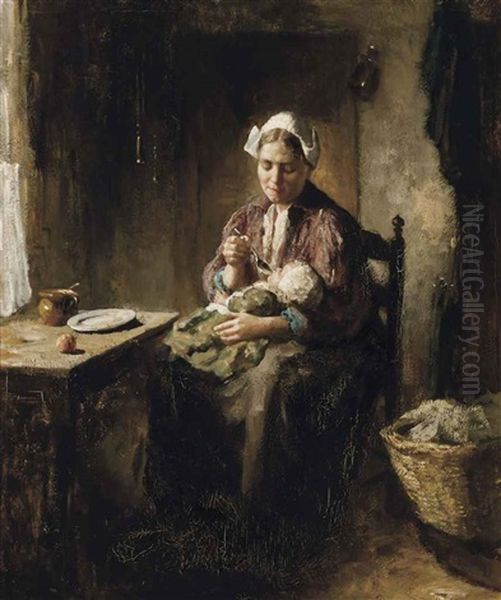
These artists shared an interest in capturing the specific light and atmosphere of the Netherlands – often characterized by soft, silvery tones and expansive skies. They frequently painted outdoors ('en plein air') to directly observe these effects. While early Hague School works often had a somber, melancholic mood, later phases saw a somewhat lighter palette. De Hoog entered the scene during this later period. He embraced the school's focus on everyday life, realism, and atmospheric effects, but often imbued his scenes with a greater sense of warmth, contentment, and gentle sentimentality than some of his predecessors.
A Signature Style: Interiors and Intimacy
Bernard de Hoog's most characteristic and celebrated works are his interior scenes depicting the lives of rural families. He excelled at capturing the humble yet comforting atmosphere of peasant cottages. His canvases frequently feature mothers tenderly caring for their infants or young children – feeding them, watching them sleep, or engaging in simple domestic tasks like sewing or preparing food. These scenes are rendered with a palpable sense of peace and familial affection.
Light plays a crucial role in his compositions. Often, a soft, natural light streams in from a window or doorway, illuminating the central figures and highlighting textures – the rough-hewn wood of furniture, the folds of simple clothing, the gleam on a ceramic jug. This careful handling of light, clearly influenced by his study of Pieter de Hooch and Johannes Vermeer, creates depth and focuses the viewer's attention on the intimate human interactions within the scene. His colour palette typically involves warm earth tones for the interiors, contrasted with the cooler light from outside, enhancing the feeling of a cozy, protected domestic space.
While realistic in detail, De Hoog's paintings generally avoid depicting the harshness or grinding poverty that could also be part of rural life. Instead, he focused on moments of quiet happiness, familial bonds, and the inherent dignity of simple living. This focus on the positive and sentimental aspects of peasant life contributed significantly to the widespread appeal of his work. His brushwork is generally smooth and controlled, allowing for clear representation of figures and objects without drawing excessive attention to the paint surface itself.
Key Works and Themes
Among De Hoog's notable works, The Sermon in the Other Church (presumably a variation of the title mentioned as The Sermon in the New Church in some sources) holds significance as the painting exhibited in Amsterdam in 1886 that first brought him public recognition. This work likely showcased his early mastery of interior scenes and his ability to capture atmosphere and human presence, setting the stage for his future success.
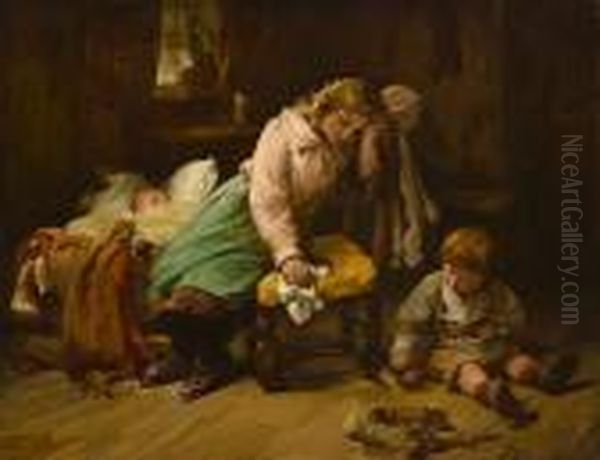
While specific titles like Interior Scene with Mother and Child are representative, many of his works carry similar descriptive titles reflecting his recurring themes: Feeding Time, The Young Mother, A Mother's Care, Saying Grace, Peasant Interior with Mother and Children. The repetition of these themes was driven by their popularity with collectors. These paintings consistently depict tidy, well-lit cottage interiors where mothers, often portrayed with gentle expressions, nurture their young children. The settings are humble but orderly, suggesting virtues of cleanliness, care, and domestic harmony.
These works resonated deeply with audiences, offering an idealized yet relatable vision of family life. In an era undergoing rapid industrialization and social change, De Hoog's paintings provided comforting images of stability, tradition, and the enduring values of home and family. They presented the rural poor not as objects of pity, but as exemplars of simple virtue and contentment.
Career, Recognition, and International Appeal
Following his successful debut in Amsterdam in 1886, Bernard de Hoog's reputation grew steadily. His paintings found a ready market both within the Netherlands and, significantly, abroad. His work became particularly popular in English-speaking countries, with substantial exports to the United States, Canada, and Great Britain. This international success speaks to the universal appeal of his chosen subject matter and the accessibility of his style.
His paintings were exhibited in various provincial and national galleries, further cementing his status. Art critics of the time acknowledged his skill. For instance, the influential German art historian Richard Muther, known for his comprehensive surveys of 19th-century painting, reportedly praised De Hoog's work, recognizing its quality within the context of contemporary Dutch art exhibitions. This critical validation, combined with strong market demand, ensured De Hoog a successful and productive career.
His ability to consistently produce appealing, well-executed paintings of domestic interiors made him one of the commercially successful Dutch artists of his generation. While perhaps not as innovative as some avant-garde figures emerging during his later career, De Hoog masterfully catered to a significant segment of the art market that appreciated traditional craftsmanship and heartwarming themes.
Later Life and Enduring Legacy
Bernard de Hoog continued to paint actively throughout his life, remaining largely faithful to the style and subjects that had brought him success. He spent his later years in The Hague, the city whose artistic school had so profoundly shaped his development. He passed away there in 1943, during the difficult years of World War II.
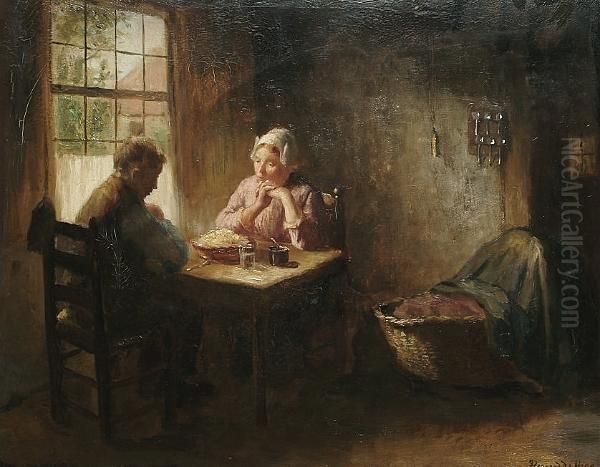
His legacy lies in his position as a prominent later exponent of the Hague School tradition, specializing in genre scenes of rural domesticity. He skillfully adapted the realism and atmospheric concerns of the school to create works that emphasized warmth, intimacy, and sentiment. While some might view his work as idealized, it undeniably struck a chord with contemporary audiences and continues to be appreciated for its technical skill and gentle charm.
De Hoog represents an important aspect of Dutch art at the turn of the 20th century – an artist who successfully navigated the transition from 19th-century realism towards modern tastes, finding a wide audience for his comforting and skillfully rendered visions of traditional Dutch life. His paintings remain popular in collections and on the art market, serving as enduring testaments to the simple joys and quiet dignity he found within the walls of humble Dutch homes, carrying forward the legacy of artists like Pieter de Hooch into a new era. His work stands alongside that of contemporaries who explored different facets of Dutch life, such as the more urban scenes of George Hendrik Breitner or Isaac Israëls, contributing to the rich tapestry of Dutch art during this period.
Conclusion: A Master of Hearth and Home
Bernard de Hoog secured his place in art history not through radical innovation, but through the consistent and skillful portrayal of a specific, deeply resonant theme: the intimacy and warmth of Dutch family life in rural settings. Emerging from an unconventional background in commerce, he dedicated himself to art, absorbing lessons from his teachers, the Dutch Golden Age masters like Pieter de Hooch, and the prevailing ethos of the Hague School. He translated these influences into a signature style characterized by careful compositions, masterful handling of light, and a focus on tender moments between mothers and children. His works, though sometimes sentimental, offered a comforting and idealized vision that found widespread international appeal, particularly in America, Canada, and Britain. As a prominent figure of the later Hague School and a contributor to Dutch Modernism, Bernard de Hoog remains celebrated for his ability to capture the enduring beauty and quiet dignity of everyday domesticity.